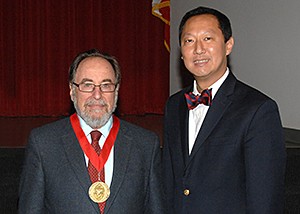
Award for Excellence Presented to Nobel Winning Scientist
Nobel Prize Winner David Baltimore, one of the worlds most influential biologists, was presented the University of Cincinnati Presidents Award for Excellence by President Santa J. Ono on May 6.
President Emeritus of the California Institute of Technology and the Robert Andrews Millikan Professor of Biology since 2006, Baltimore visited UC to present a lecture as a part of Research Week, a collaboration of UCs Academic Health Center, UC Health, Cincinnati Childrens Hospital Medical Center, the Cincinnati Department of Veterans Affairs Medical Center, and the Cincinnati Education and Research for Veterans Foundation.
Baltimore shared the Nobel Prize in 1975 with another researcher who simultaneously but separately had made the break-though finding that RNA viruses could make copies of themselves. Prior to that, the conventional wisdom in molecular biology was that genetic information was transmitted only from DNA to RNA.
Baltimore also devised the Baltimore classification system, a system that classes viruses into seven groups according to their genome type and method of replication. His work had enormous implications for fields beyond virology including oncology, molecular and cell biology, and biotechnology.
His work also provided keys to understanding the life cycle of retroviruses such as HIV, and as a result Baltimore has contributed widely to the understanding of cancer, AIDS and the molecular basis of the immune response.
In the mid-1970s, he played an important role in creating a consensus on national science policy regarding recombinant DNA research. He served as founding director of the Whitehead Institute for Biomedical Research at MIT from 1982 until 1990. An early advocate of federal AIDS research, Baltimore co-chaired the 1986 National Academy of Sciences committee on a National Strategy for AIDS and was appointed in 1996 to head the National Institutes of Health AIDS Vaccine Research Committee.
His present research focuses on control of inflammatory and immune responses, on the roles of microRNAs in the immune system and on the use of gene therapy methods to treat HIV and cancer in a program called Engineering Immunity. He also serves as director of the Joint Center for Translational Medicine, an activity that joins Caltech and UCLA in a program to translate basic science discoveries into clinical realities and where an active clinical program is under way.
Related Stories
Lindner students recognized for academic excellence,...
April 17, 2024
The Carl H. Lindner College of Business held its annual student awards ceremony on April 10, celebrating the accomplishments of its students at every level.
UC’s Ground Floor Makerspace births combat robots
April 17, 2024
In the heart of UC's 1819 Innovation Hub lies the Ground Floor Makerspace, an advanced and active hub of ingenuity where students, faculty and the community converge to bring their ideas to life. This includes being the birthplace of robots much like miniature race cars, combating fender to fender in an enclosed boxing ring. Combat robots like UC's Maximizer will again be fighting for first place in the National Havoc Robot League (NHRL) competition, slated for April 20.
ServiceNow Vancouver upgrade coming Friday, April. 26
April 17, 2024
The IT Service Portal and Knowledge Base may be intermittently unavailable from 11:45p.m., Friday, April 26, until 4 a.m., Saturday, April 27, during a planned ServiceNow upgrade.
